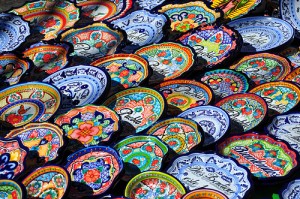Talavera isn’t just any kind of pottery, though, and not just any artisan can make it. The form, which is known in Spain as majolica, is a tin-enameled earthenware whose hard white glaze provides a backdrop against which the vivid glazes applied to it can visually pop. And those vivid glazes are selected carefully; in fact, for Mexican talavera to be considered authentic, it can only be painted in one or more of six colors– black, blue, green, orange, yellow, or mauve–all of which must be made of natural dyes and all of which must be painted onto the piece of tile or pottery by hand. The clay, a mix of a lighter and darker barro, must also come from Puebla and the forms into which it is shaped are fired twice. The process is hands-on, time-intensive, and elaborate.
In Mexico, the center of authentic talavera production is the state of Puebla, whose artisans have been renowned for the ceramic form since it was introduced to the country. In fact, Puebla has denominación de orígen status as the source of authentic talavera, and though the tradition of this art form originated in Europe, local producer Uriarte claims that Puebla is the largest producer of talavera in the world today. Read full article here: The Latin Kitchen

